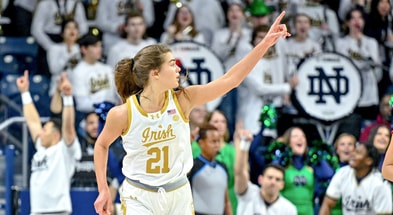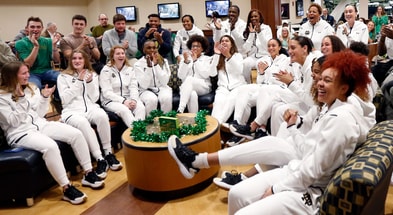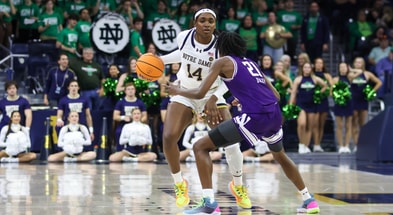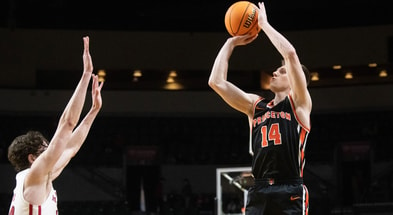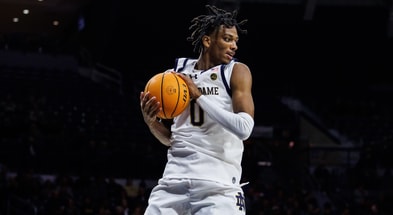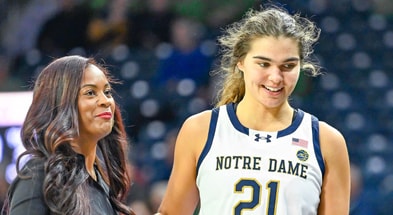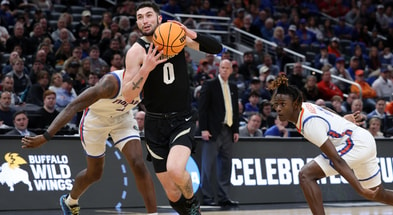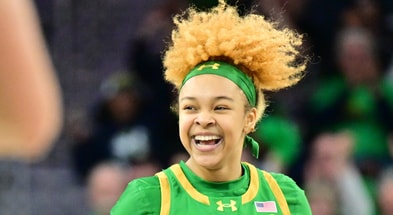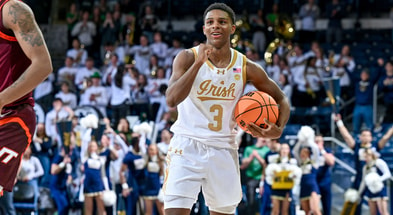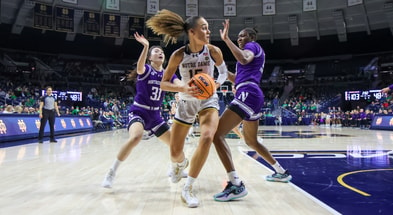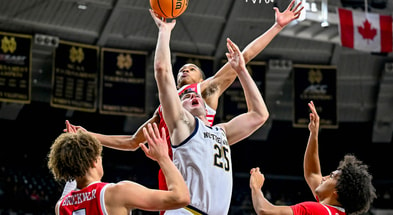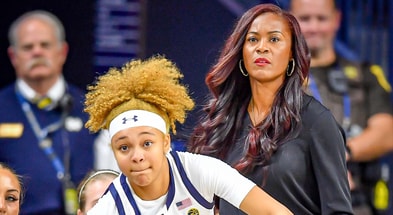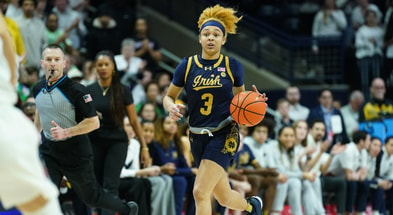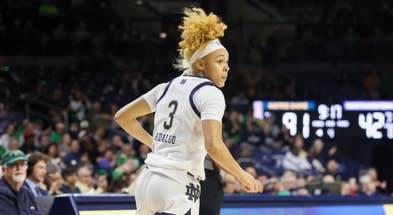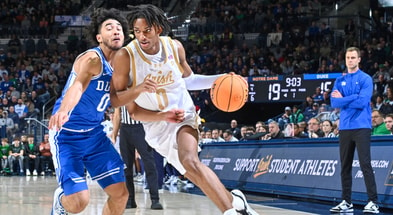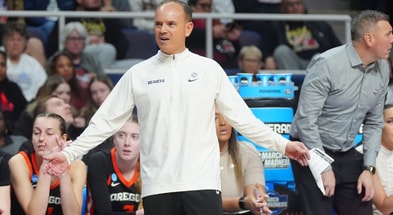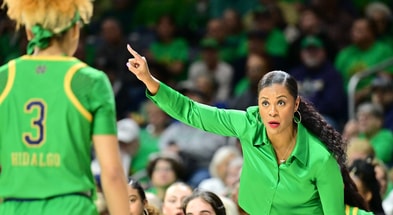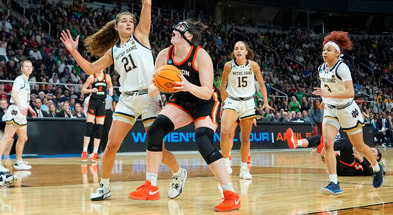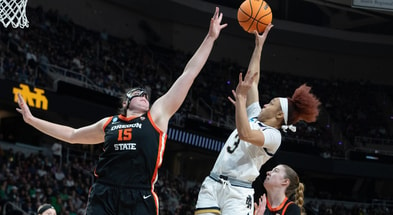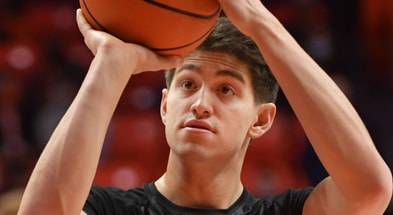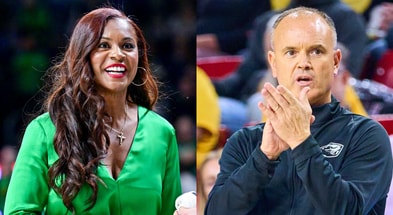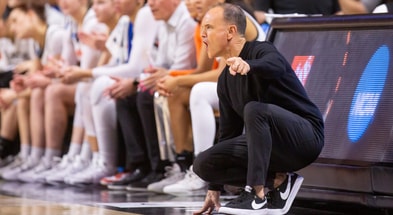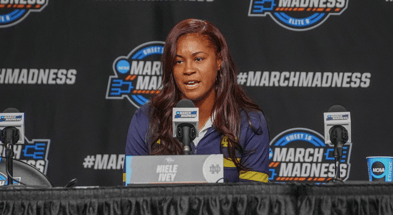How Notre Dame PG and ‘quarterback’ Prentiss Hubb turned a benching into a career-best stretch
All due respect to trainer extraordinaire Nixon Dorvilien, the Notre Dame men’s basketball team doctor’s office is not in Rolfs Hall. In fact, it’s not even an office.
Head north on Route 23 for about 10 minutes from campus to Heritage Square in nearby Granger, and you’ll find the place where Mike Brey meets his patients: Uptown Kitchen. Breakfast with Brey there is the team’s equivalent of an individual checkup. And one early December morning, he sent a team captain a doctor’s note.
Prentiss Hubb hadn’t been himself, and it’s no coincidence Notre Dame followed suit. The Irish were 3-3 in their first six games and had dropped two in a row. Hubb, the four-year starting point guard, had dropped two zeros in the points column, including the most recent game at Illinois. He committed eight turnovers in another. All told, he was shooting 11 of 49 (22.4 percent) from the field with an 18-to-15 assist-turnover ratio.
PROMOTION: Sign up for just $1 for first year at Blue & Gold
Hubb had been no beacon of consistency his first three years at Notre Dame, but whatever malady had stricken him now was entirely new.
“Breakfast at Uptown Kitchen is my doctor’s office for all the guys,” Brey said. “We had him through there and talked a little bit, because I wanted to tell him I’m not going to start him and will bring him off the bench.”
Lineup changes are, at minimum, monthly occurrences for most coaches. This one, though, was different. Hubb had started every game but five since his freshman year. The exceptions are the first three of his career, another later in his freshman season and a January 2021 road game at Miami where Brey sat the entire starting five. Furthermore, Brey was tabbing freshman guard Blake Wesley as Hubb’s replacement. So, yeah, this one had to be handled carefully.
“There wasn’t too much to talk about,” Hubb said. “I was playing bad. Something had to change. We can’t keep doing the same things if we’re losing.”
That self-awareness guided him as he not only found his way back, but thrived upon re-insertion. Notre Dame, in turn, picked itself up from a 4-5 start to finish the regular season at 22-9 and 15-5 in the ACC. The Irish are the No. 2 seed in the conference tournament and, barring a collapse Thursday and mass bubble chaos, are headed to March Madness.
RELATED:
• Notre Dame pre-spring practice depth chart projection, defense
• Notre Dame pre-spring practice depth chart projection, offense
Notre Dame’s offense relies less on Hubb now than it did the past three years — Wesley’s emergence as an NBA prospect is primarily responsible for that change — but that reduced burden has fostered career-best efficiency numbers.
Hubb set conference-game career bests in three-point percentage (34.7), offensive rating (114.1) and turnover rate (10.2 percent, fifth in the ACC). He shot 47.3 percent on two-pointers and averaged 4.4 assists per game in ACC play. At one point in mid-February, he owned the best assist-turnover ratio of any player in the country in league games (5.7). Defensively, no ACC player was called for fewer fouls per 40 minutes (1.4) than him in conference games.
On top of it all, the bond he formed with Wesley remained strong, even as understudy temporarily replaced teacher. His willingness to guide Wesley never waned.
“After a tough start, he’s in total control of this group,” Brey said.
Brey’s move helped light the fuse on it.
“He has always been able to find that extra push in me,” Hubb said.
A framework shift
Hubb’s first game off the bench was Notre Dame’s worst of the year, a noncompetitive 73-57 loss to Boston College Dec. 3 that still stands as the Irish’s lone Quadrant 3 or 4 loss on their NCAA Tournament résumé.
Hubb’s team-high 15 points in that game were barely worth acknowledging. His five-point, two-assist game in the 64-56 loss to Indiana Dec. 18 felt like more of the same, not a breakthrough. Brey, though, decided on the bus ride back from that game to start him again, replacing senior Cormac Ryan. He was onto something. Hubb scored in double figures three of the next six games, with 29 assists against eight turnovers. More importantly, Notre Dame went 6-0.
Starting Wesley and sitting Hubb for some introspection was one move in Brey’s greater plan for an in-season repair job on offense. Notre Dame lacked direction, he thought, and those concerns boiled over at Boston College. The solution was to add some structure to a typically free-flowing system and dial back the pace.
“We spent so much time defensively in the summer, because that was the elephant in the room,” Brey said. “Offensively, watching us at Boston College, we were all over the floor, we just needed more. And there was a tempo control aspect to this.
“We needed a framework to play off a little bit more. Tempo control helped our defense because they don’t have to guard as many possessions. It’s a page out of the Virginia book.”
To make it work, though, it needed an efficient “quarterback” — in Brey’s terms — to pilot it. Hubb was the natural choice if he could pull the wheel around on a woeful start. In doing so, he has demonstrated innate feel for running the slower pace and picking spots to push the ball in transition.
For much of January and early February, the Irish leaned into slow games, with Hubb as the puppeteer. A six-assist, one-turnover night in a Feb. 2 win at then-ACC leader Miami stands as some of his best work at the controls. That game was a 62-possession affair.
Lately, Brey has loosened the reins and let the Irish run. The open floor is Wesley’s stage to shine, but Hubb has hunted transition chances more frequently too. He started several fast breaks, including a coast-to-coast layup, in a 74-70 loss to Florida State March 2 that would have been more lopsided without Notre Dame’s transition threat.
Whatever the pace, Hubb’s self-assurance since his doctor’s visit is impossible to miss. He iced a 69-65 win over Virginia Jan. 29 with two free throws in the closing seconds, answering a challenge teammate Dane Goodwin issued him. Make both, Goodwin said. He told Goodwin not to worry. It didn’t matter his free throw percentage sat in the low 60s at the time.
“I got ice in my veins,” Hubb said afterward. “I’m going to make them shots when it counts.
“I went up to the free throw line and wasn’t worried, hands weren’t wet or anything.”
A month later, Hubb sat at a dais in the Hammes Auditorium inside Purcell Pavilion next to Ryan, listening as Ryan explained his own in-season resurgence. Ryan’s career-best stretch of scoring began when Brey put him back in the starting lineup following an injury to Nate Laszewski. He hasn’t left since.
There is a correlation, Ryan said.
Hubb cut in to confirm.
“It’s that getting benched effect,” Hubb said. “Every time you go to the bench, you start balling. Everybody does it.”
